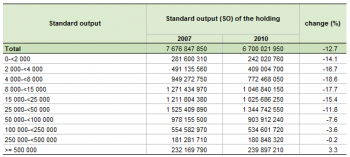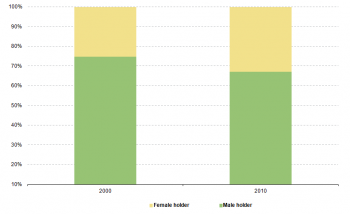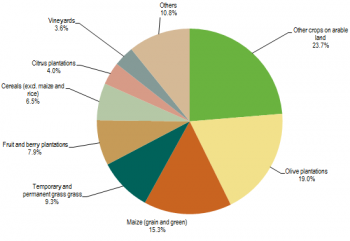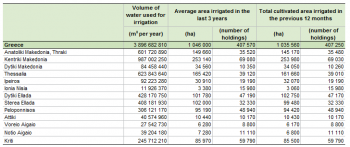Archive:Agricultural census in Greece
- Data from November 2012. Most recent data: Further Eurostat information, Main tables and Database.
This article is part of a series of country-specific essays on the results of the European Union (EU) Farm structure survey (FSS) 2010. The FSS collects information on the structural characteristics of agricultural holdings (land use, livestock and labour force) and is carried out by all European Union Member States every 10 years as an Agricultural census, with two or three additional, intermediate sample surveys carried out in-between. The present analysis of Greek farm structure includes a comparison with the Agricultural census 2000.

Source: Eurostat (ef_kvaareg) (ef_ov_kvaa) (demo_pjan) and FSS 2000 and 2010
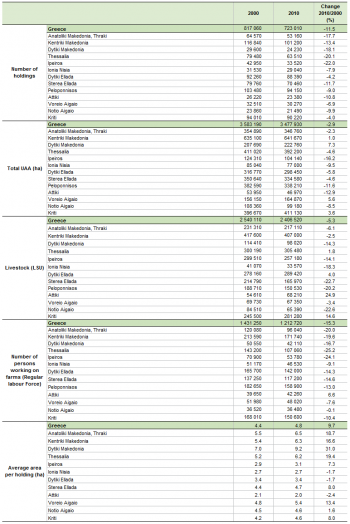
Source: Eurostat (ef_kvaareg) (ef_ov_kvaa) and FSS 2000 and 2010
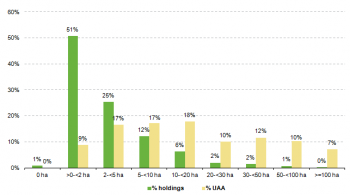
Source: Eurostat (ef_kvaareg) (ef_ov_kvaa)
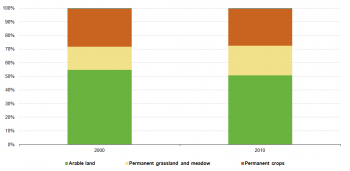
Source: Eurostat (ef_lu_ovcropaa) (ef_oluaareg)
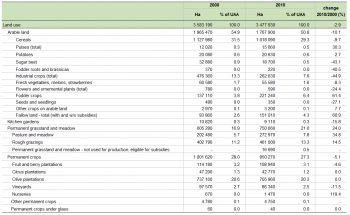
Source: Eurostat (ef_lu_ovcropaa) (ef_oluaareg)
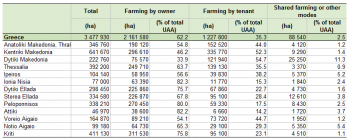
Source: Eurostat (ef_mptenure)

Source: Source: Eurostat (ef_pmhouscatlaa)
Main statistical findings
Key indicators
As shown in Table 1, there were 723 010 agricultural holdings in Greece. Although 94 050 farms ceased their activity between 2000 and 2010 (-12%), Greece was one of the EU Member States with the largest number of holdings in 2010; only Romania (3.8 million farms), Italy (1.6 million), Poland (1.5 million) and Spain (1.0 million) recorded higher numbers.
The utilised agricultural area (UAA) also decreased in Greece, though it did so at a lower rate (-2.9%) and stood at 3.5 million hectares in 2010, covering about a quarter of Greek territory. The Czech Republic (3.5 million ha) and Sweden (3.1 million ha) had similar UAAs.
As the fall in the number of holdings was sharper than that of the agricultural land area, the average size of holdings rose between the two reference years, from 4.4 to 4.8 hectares per farm. However, Greece was among the EU Member States with the lowest average area per farm, with only Romania (3.4 ha per farm), Cyprus (3.0 ha) and Malta (0.9 ha) having smaller values.
As widely seen across the EU-28, the agricultural labour force also decreased in Greece, from 1.4 million in 2000 to 1.2 million in 2010 (-15%). However, the regular agricultural labour force represented a quarter of the active population[1] in 2010, which was one of the highest proportions among the EU Member States.
As presented in Table 1, there were about 2.4 million livestock units (LSU) in Greece, a 5.3% decrease compared to 2000 (-133 590 LSU). Among the other EU-28 countries, Hungary (2.5 million LSU) and Portugal (2.2 million LSU) had similar values.
Regional key indicators
Table 2 presents the key indicators by NUTS 2 region, shedding light on the local characteristics of Greek agriculture. The region of Kentriki Makedonia had the highest number of farms with 101 200 in 2010, accounting for 14% of the total. Large numbers of farms were also found in Peloponnisos (94 150), Kriti (90 220) and Dytiki Ellada (88 390), which accounted for 13%, 12% and 12% respectively of the Greek total. At the other end of the scale, the lowest number of holdings (21 490) was recorded in Notio Aigaio, 3.0% of the total.
As well as registering the largest number of holdings, the region of Kentriki Makedonia also had the highest agricultural area of 641 670 hectares, accounting for 18% of the country’s UAA. Kriti (12%), Thessalia (11%) and Anatoliki Makedonia (10%) were the only other regions with double digit proportions, with areas of 411 130, 392 200 and 346 760 hectares respectively. The smallest proportions of agricultural land were observed in Attiki (46 970 ha) and the island region of Ionia Nisia (77 000 ha), 1.4% and 2.2% respectively in 2010.
In terms of livestock, measured in livestock units (LSU), Kentriki Makedonia had the largest number (407 000 LSU) and accounted for 17% of the total number of farm animals; slightly down compared with 2000 (16%). There were also large numbers of livestock in Thessalia (305 480 LSU, 13%), Dytiki Ellada (289 420 LSU, 12%), Kriti (281 280 LSU, 12%) and Ipeiros (257 180 LSU, 11%).
As shown in Table 2, 171 740 people were working on farms in Kentriki Makedonia in 2010, the largest workforce in the country and accounting for 14% of the total labour force. Peloponnisos had the second biggest workforce with 158 900 people (13%), followed by Kriti (150 600 workers) and Dytiki Ellada (142 000 workers), each accounting for 12%. At the other end of the scale, the Aegean island region of Notio Aigaio had the smallest number of workers (36 480 persons) and accounted for only 3.0% of the agricultural labour force.
Agricultural holdings
In contrast to the general pattern observed across the EU-28, Greek agricultural area was quite evenly distributed among all the size classes of farms (see Figure 1). The highest proportion of agricultural land was recorded for farms with 10 to 19.9 hectares of UAA (18%). Farms with 5 to 9.9 hectares (17%) of land and those with 2 to 4.9 hectares (17%) accounted for similarly high proportions. Farms with 100 hectares or more covered the lowest proportion of UAA (7.2%).
If the number of farms is taken into account, the size classes do not look so homogeneous, as holdings with less than 2 hectares of agricultural land (373 340) were by far the most common; they accounted for over half of the total. Holdings with 2 to 4.9 hectares (183 820) represented a quarter of Greek farms and holdings with 5 to 9.9 hectares accounted for 12%. In total, farms with less than 10 hectares of agricultural land (644 930 farms) represented 89% of the total number of farms in Greece in 2010.
See detailed data at NUTS 2 level for 2000 and 2010
Economic size of the farm
As shown in Table 3, the total standard output (SO) of Greek agricultural holdings was EUR 6 700 million in 2010, a 13% decrease from 2000. Among the other EU Member States, Belgium (EUR 7 248 million) and Austria (EUR 5 879 Million) had similar values. Drops were seen across all size classes of farms, except for the largest (farms with over EUR 500 00 of SO), which increased by 3.3% (+ EUR 7.7 million).
In 2010 three middle economic size classes of farms accounted for the largest proportions of the total Greek standard output. These were farms with an economic size of EUR 25 000 to 49 999, those with EUR 15 000 to 24 999 and those with EUR 8 000 to 14 999. Together they accounted for half of the entire country’s standard output.
Among the Greek regions, Kentriki Makedonia had the highest SO (EUR 1 302 million) and accounted for 19% of the country’s total. The second highest was observed in Peloponnisos with EUR 866 million (13%), followed by Dytiki Ellada (EUR 764 million, 11%) and Thessalia (722 million, 11%). At the other end of the scale, the Ionian island region of Ionia Nisia (1.8%) and Aegean island region of Notio Aigaio (2.1%) accounted for the smallest proportions, at EUR 124 million and EUR 144 million respectively.
See detailed data at NUTS 2 level for 2010 and 2007
Agricultural holdings by main type of farming
Farms specialised in specific types of crops were dominant in Greece. As shown in Figure 2, specialist olive farms made up the largest share (38%) of farms in 2010. General field cropping farms accounted for the second largest proportion (10.1%). Farms specialised in cereals, oilseed and protein crops, those with various permanent crops and specialist fruit and citrus fruit farms all accounted for similar proportions (8.4 - 8.6%).
Specialist olive farms and general field cropping farms also represented the largest proportions of standard output, although for this indicator the latter type was the most dominant. It accounted for 19% of the total Greek standard output, while specialist olive holdings represented 15%.
See detailed data at NUTS 2 level for 2010
Land use
The Utilised Agricultural Area (UAA) is the total area used by a farm, regardless of the type of tenure or whether it is used as a part of common land. It is made up of four major components: arable land, permanent grassland and meadow, permanent crops and kitchen gardens.
In 2010, the Greek UAA mainly consisted of arable land (51%), permanent crops (27%) and permanent grassland and meadow (22%). Between 2000 and 2010, the area of arable land fell by 10% to 1.8 million hectares and permanent crops also reduced in area by 5.1% to 950 270 hectares. In contrast, land under permanent grass and meadows increased by 24% to 750 660 hectares in 2010.
See detailed data at NUTS 2 level for 2000 and 2010
Arable land
As shown in Table 4, Greek arable land was essentially made up of cereals (29%), industrial crops (7.6%), fodder crops (6.4%) and fallow land (4.3%). Among these, industrial crops registered the largest reduction in area, falling by 45% to 262 630 hectares, followed by cereals, down by 9.7% to 1.0 million hectares. In contrast, the areas of fodder crops and fallow land both recorded significant increases of 61% over the inter-census decade, to 221 240 and 151 010 hectares respectively in 2010.
See detailed data at NUTS 2 level for 2000 and 2010
Permanent grassland
Over the 2000-2010 timeframe, the area of permanent grassland and meadow increased by 24% to 750 660 hectares. Among its components, pasture and meadow increased the most (by 35% to 272 940 hectares) while the area of rough grazing increased more moderately (14% to 461 000 hectares).
See detailed data at NUTS 2 level for 2000 and 2010
Livestock
Statistics on livestock use two different units of measurement, the number of head (number of animals) and the livestock units (LSU), with the latter allowing comparison between different types.
In Greece, there were about 2.4 million LSU in 2010, a 5.2% decrease from 2.5 million in 2000. Among the other EU Member States, Hungary (2.5 million LSU) and Portugal (2.2 million LSU) had similar values. In relative terms, there were 0.21 LSU per inhabitant in 2010; the corresponding value was slightly higher in 2000 (0.24), as the Greek population increased (+3.5%) while livestock numbers fell (-5.3%) over the inter-census period.
The number of holdings with livestock decreased by 30% to 273 160 in 2010; about 119 800 farms with animals ceased their activities or sold their livestock between the two reference years. As the fall in the population of livestock farms was sharper than that in the livestock population, the average LSU per farm increased from 6.4 LSU per holding in 2000 to 8.8 in 2010. Livestock farms decreased in numbers across almost all size bands, with only two exceptions: farms with 50 to 99 LSU, which increased by 21%, and holdings with 100 to 499 LSU (+15%).
In Greece, sheep were by far the most common livestock with 915 680 LSU in 2010, an increase of 5.0% from 2000 and representing 38% of the total livestock population. Cattle were the next most common with 465 600 LSU or 19%; their number remained stable over the years. In contrast, goats experienced a sharp fall of 21%, although they remained the third most common livestock type in 2010 with 421 320 LSU, which corresponded to 18% of the total population of farm animals.
In terms of the regional distribution of livestock, the highest number of cattle (140 850 LSU) were observed in Kentriki Makedonia, accounting for 30% of the cattle population. The largest numbers of sheep were registered in Dytiki Ellada (147 880 LSU) and Thessalia (119 730 LSU) with proportions of 16% and 13% respectively of the total sheep population.
See detailed data at Nuts 2 level for 2010 and 2000
Labour force
As shown in Table 6, 1.2 million people were working on Greek farms in 2010. Although this was a 15% decrease compared to 2000, Greece had one of the largest agricultural labour forces within the EU-28. If the annual work unit (AWU) is taken into account, the decrease appears sharper (-27%), falling from 512 860 AWU in 2000 to 372 750 AWU in 2010.
See detailed data at NUTS 2 level on holders' age and gender for 2010 and 2000
See detailed data at NUTS 2 level on type of labour force for 2010 and 2000
Management practices
Type of tenure
In Greece, about 2.2 million hectares of agricultural area (62%) were farmed by the landlord in 2010 and a further 1.2 million hectares (35%) were farmed by tenants. Regionally, the proportions of area farmed by owners was highest in Ionia Nisia (82%), Attiki (82%) and Peloponnisos (80%) which in turn meant these regions had lower proportions farmed by tenants. Conversely, the smallest percentages of area farmed by landlords were recorded in Dytiki Makedonia (34%) and Kentriki Makedonia (46%) meaning these regions had higher than average proportions of land farmed by tenants.
Only a small portion of Greek agricultural land (2.5%) was farmed in partnership by the landlord and the sharecropper under a written or oral share-farming contract, covering 88 540 hectares. The largest area farmed like this (25 250 hectares) was in Dytiki Makedonia, 11% of the total UAA in this region.
Irrigation
The total Greek irrigable area was 1.3 million hectares and covered 37% of the entire agricultural area in 2010. The area actually irrigated in the 12 months prior to the survey was slightly smaller (about 1.0 million hectares). Among the other EU-28 countries, the area irrigated was larger in Spain (3.0 million ha), Italy (2.4 million ha) and France (1.6 million ha), though the proportion of agricultural area irrigated was highest in Greece (30%).
The largest types of areas irrigated were other crops on arable land and olive plantations at 243 550 hectares (24% of total area irrigated) and 195 580 hectares (19%) respectively, as shown in Figure 7.
In Greece 3 763 cubic metres of water were used per hectare of irrigated land in 2010, calculated using the area irrigated in the 12 months prior to the survey. It must be noted that water used for irrigating kitchen gardens and glasshouse crops is not included. On a regional basis, farms in Notio Aigaio used the most water per hectare (5 765 cubic metres per ha) while holdings in Dytiki Makedonia used the least (2 480 cubic metres per ha).
Animal housing
In Greece, there were 16 790 holdings farming 651 780 cattle in 2010 (see Table 9). The most common type of cattle housing, both in terms of the number of farms and the animal capacity, was that where the animals are tied to their places and the manure is typically removed mechanically as farmyard manure. There were 5 160 holdings with this type of housing (31% of all holdings with cattle) with a total capacity of 218 530 places (34% of the total cattle population).
The second most popular type of animal housing was that where the cattle are allowed to move freely and the manure is removed mechanically as farmyard manure. There were 4 220 holdings with this type (25% of all holdings with cattle) and the total capacity was 194 490 places (30% of the cattle population).
Other gainful activities
As shown in Table 10, there were 10 450 holdings with other gainful activities in Greece. Across the other EU-28 countries, Slovenia (12 520 farms) had a similar number. These farms, which represented 1.4% of Greek holdings, undertook activities other than farm work, directly related to the holding and having an economic impact on the farm.
Information on other gainful activities was collected for eleven categories and a holding could have more than one activity. Processing of farm products (4 970 farms) was the most common extra source of income in Greece, followed by contractual work, which could take the form of contractual agricultural work (4 490 holdings) and contractual non-agricultural work (300 farms).
Regionally, the largest number of holdings with other gainful activities was located in Kentriki Makedonia (1 640 holdings), followed by Sterea Ellada (1 380 holdings), Thessalia (1 310 farms) and Anatoliki Makedonia and Thraki (1 000 farms). However on a proportional basis, 3.1% of all holdings in Dytiki Makedonia were undertaking other gainful activities, the highest proportion across all regions.
See detailed data at NUTS 2 level for 2000
Organic farming
Organic agriculture is an ecological production management system that promotes and enhances biodiversity, biological cycles, and soil biological activity. It is based on the minimal use of off-farm inputs and on management practices that restore, maintain or enhance ecological harmony.
In Greece, the number of holdings practising organic farming increased dramatically between 2000 and 2007 from 1 460 to 27 700. In 2010, however this almost halved to 14 530 farms, accounting for 2.0% of the country’s holdings. The agricultural area under organic farming followed the same trend, increasing rapidly from 52 090 to 192 930 hectares between 2000 and 2007, then decreasing sharply to 116 420 hectares in 2010. This area accounted for 3.3% of the country’s UAA.
See detailed data at Nuts 2 level for 2010, 2007, 2005, 2003 and 2000
Data sources and availability
Methodological notes Greece – Agricultural census 2010
In Greece the first Agricultural Census was carried out in 1950 after the Second World War. Between 1966 and 1967, when the country was still an associated member of the EU, Greece also conducted the first sample survey of Agriculture and Livestock holdings. Since its accession to the EU in 1981, Greece has been carrying out the FSS every two years, in compliance with EU regulations. The Hellenic Statistical Authority is the responsible body, which collects data through its regional offices.
Survey on agricultural production methods (SAPM)
In 2010 a unique survey was carried out together with the Agricultural census, the Survey on agricultural productions methods (SAPM). This survey collected data at regional level needed to establish agri-environmental indicators as indicated in COM final 508/2006 and to evaluate the greening of the Common agricultural policy.
Data were collected according to the specifications listed in Annex V of the above mentioned regulation, namely data on tillage methods, soil conservation, landscape features, animal grazing, animal housing, manure application, manure storage and treatment facilities and irrigation.
In Greece, the SAPM was conducted as a sample survey; a one-stage stratified random sampling method was employed to select 59 967 units. The response rate was 72% (43 110 holdings) and accounted for 6.3% of the entire population of agricultural holdings.
Reference period
Data on the Agricultural Census 2010 were collected with reference to 1 November 2009. However, information on rural development refers to the three years prior to the reference date, whereas data on production methods, crops and labour force refer to the 1 October 2008 – 30 September 2009 timeframe.
Thresholds for agricultural holdings
In compliance with Regulation 1166/2008 of 19 November 2008, the FSS 2010 targeted all agricultural holdings with at least 0.1 hectares of agricultural land or 0.05 hectares of glasshouse crops. Moreover, farms complying with a set of physical thresholds related to certain types of livestock were also included in the target population of both the FSS and the SAPM.
Common land
Common land is land that does not directly belong to any agricultural holding but on which common rights apply. It can consist of pasture, horticultural or other land. The treatment of the common land used by an agricultural holding might differ from country to country.
In Greece, common land is mainly permanent grassland used as pasture for cattle, sheep and goats. It covered about 1.7 million hectares in 2010.
Geo-reference of the holding
Information on the geographical location of the agricultural holdings was collected through the geographic coordinates of the central points of the locality where the farm is located.
Economic size
From FSS 2007 onwards, the Standard output (SO), a new classification of the economic size of the holding, is used. The SO has replaced the Standard gross margin (SGM) used before. Nonetheless, for comparability reasons, in FSS 2007 both classifications are available.
Volume of irrigation water
The volume of water used for irrigation was calculated for the first time in 2010, within the context of the Survey on Agricultural Production Methods. It was estimated taking into account information on land use, crop water needs, irrigation methods as well as meteorological and soil data. The model also made use of the Geographic Information System technology to account for local variations in cropping, soil and climate. In contrast, it did not include the irrigated area of kitchen gardens and greenhouses, which covered about 0.3% of the UAA in 2010.
Context
European Commission Rural development policy aims to improve competitiveness in agriculture and forestry, the environment and the countryside, as well as to improve the quality of life in rural areas, and to encourage the diversification of rural economies.
As agriculture has been modernised and the importance of industry and services within the economy has increased, agriculture has become much less important as a source of jobs. Consequently, increasing emphasis is placed on the role farmers can play in rural development, including forestry, biodiversity and the diversification of the rural economy, in order to create alternative jobs and provide environmental protection in rural areas.
The FSS continues to adapt in order to provide timely and relevant data to help analyse and follow these developments.
See also
- Agricultural census 2010
- All articles on Greece
- All farm structure articles by country (2007)
- Farm structure statistics
Further Eurostat information
Publications
- Agriculture, fishery and forestry statistics — Main results – 2010-11 - 2012 edition
- Farm Structure Survey in Greece - 2007 - Issue number 96/2009
- Farm Structure in Greece - 2005 - Issue number 59/2007
- Structure of agricultural holdings - Greece 2003
Main tables
- Agriculture, see:
- Farm structure: historical data (1990-2007) (t_ef)
Database
- Agriculture, see:
- Farm structure (ef)
Dedicated section
Methodology / Metadata
- Farm structure (ESMS metadata file - ef_esms)
- Methodological Report - FSS 2010 Greece
- Methodological Report - FSS 2007 Greece
Source data for tables and figures (MS Excel)
Other information
- Regulation 1166/2008 of 19 November 2008 on farm structure surveys and the survey on agricultural production methods and repealing Council Regulation 571/88
- Regulation 1200/2009 of 30 November 2009 implementing Regulation 1166/2008 on farm structure surveys and the survey on agricultural production methods, as regards livestock unit coefficients and definitions of the characteristics
External links
Notes
- ↑ A value calculated over the active population in the 4th quarter 2010 of the EU Labour force survey (LFS) Population, activity and inactivity - quarterly data
